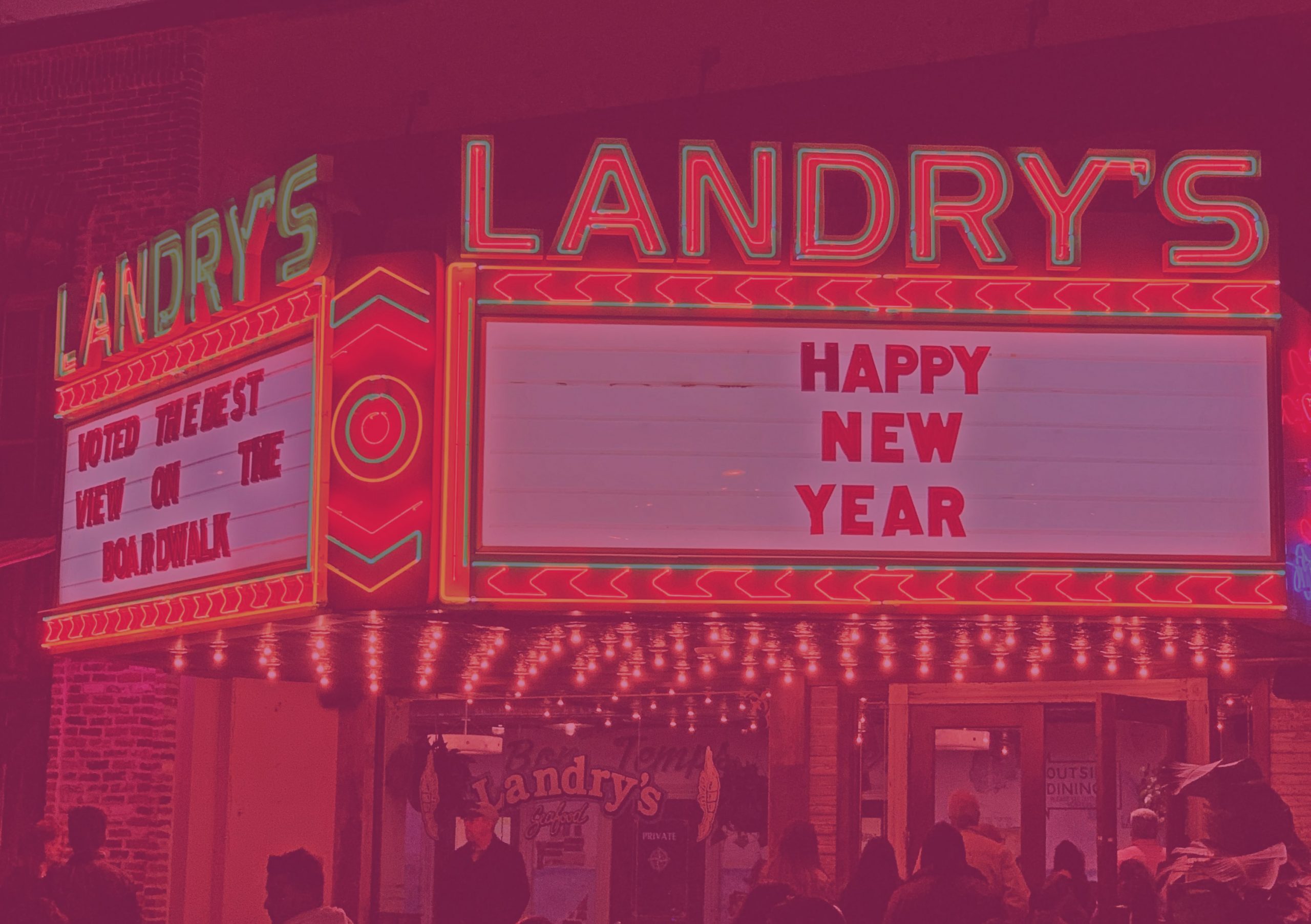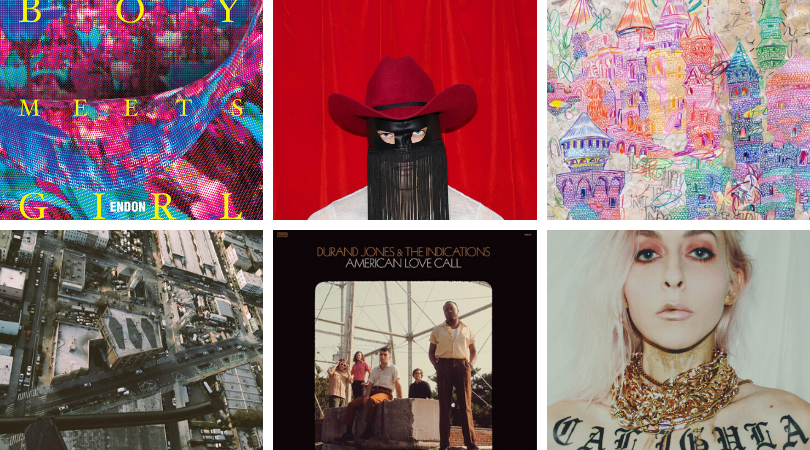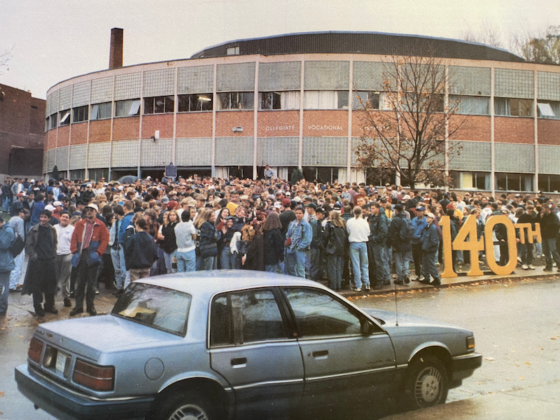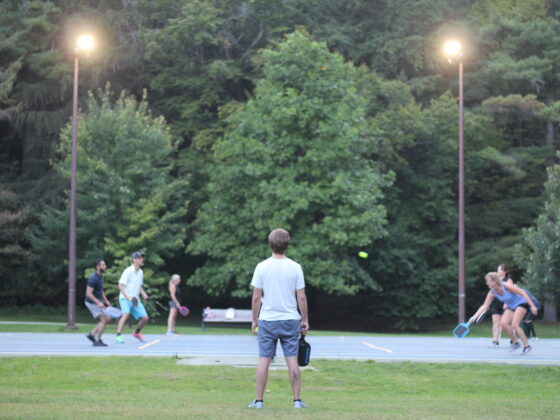Around the 2-hour mark of Quentin Tarantino’s Once Upon A Time.. In Hollywood, having just followed its three leads through two February days in the Los Angeles of 1969, the action jumps forward six months to August and a narrated sequence unfolds. Here, as we notice how our characters have changed physically — one is now 8 months pregnant, one has gone from clean-cut pompadour to shaggy dog hippie, another is perhaps even more weathered than before— the narrator summarizes what has happened to them in the intervening months, and all the while Out Of Time by The Rolling Stones rings out, intoning that while only six months have passed, everything has changed. It’s a sequence rather uncharacteristic of Tarantino who usually favours music as an ironic counterpoint rather than something that speaks so directly to the action. It’s also especially poignant, laced with a vague melancholy as it signals that these characters and the city they inhabit have in many ways come to the end of the line.
This is the sunset of an era.
About five months have passed since I first watched this sequence unfold in 35mm at the New Beverly in Hollywood, and I can’t seem to shake it. Not only does its emotion continue to resonate in the context of the film, but over the past few weeks, it’s begun to act as a source for my own reflection, a spark of contemplation as the chapter closes on another year, another decade, another era.
More and more, I’ve found that one of the more revealing ways of assessing a certain period in my own life is by reflecting on the art — particularly, the movies — that have resonated deepest during that period. What was I preoccupied with? Challenged by? Rallying against? Fantasizing about? Where was I falling flat on my face? Spinning my wheels? In what ways was I prospering? What was my general outlook, mood, temperament? Devote some time to reflect on the stories, the characters, and the tone of the films that have stuck to my soul and there it all is: my hopes and fears, desires and insecurities, successes and failures, material and dream lives.
In this spirit, I’ve set out to examine the movies from the past decade that continue to haunt me. What secrets did they hold? What power did they wield? Some of these can be found on more traditionally “objective” decade-end lists (Certified Copy, The Wolf Of Wall Street), while others — most others — are highly personal choices, a few of which were dismissed by critics and audience alike (Passion, The Counsellor)… and still others, well, I simply ran out of the time to write about them, but want to pay them mention (Clouds Of Sils Maria, The House That Jack Built).
If there’s a connecting tissue between these films, I suspect it has something to do with the shadow-selves found within the artist and the art. Whether it be lurking below the surface or threatening to swallow the entire universe whole, it’s there. It’s there, and yet somehow, amidst the most troubling events there exists a light. It might be shining from within the story or it may be embedded in the very fabric of the art itself, glowing soft like an ember, but it’s there, creating enough space to allow darkness to become a source of creation.
Certified Copy (Abbas Kiarostami, 2010)
When we talk about special effects at the movies, we’re generally referring to computer-generated imagery painted on the canvas. It may be big and flashy and colourful and in service of spectacle, or more subtle and designed to blend seamlessly into the environment. Of course, both are perfectly valid, yet I can’t help but wish that the term be somewhat redefined, which is to say that although no computer-generated imagery is present, as far as I’m concerned, Abbas Kiarostami’s Certified Copy is one of the most astonishing special effect sequences I have ever seen on screen.
The set-up is deceptively simple: A British Art Historian gives a lecture in Italy on his just-published book which posits the idea of a copy holding an intrinsic value equal to that of its original. A French woman — we assume a fan — introduces herself and slips her number to the author, and the next day the pair spend an afternoon wandering through a Tuscan village together. As far as we can tell, they’ve never met before, yet, as we accompany them over the course of the afternoon we bear witness to something puzzling, then astonishing; something that couldn’t be executed through any other medium; something that calls into question everything that has come before, including our notions of time, relationship, identity, and authenticity.
It’s a film rich in symbolism, yet its metaphorical pyrotechnics would serve as mere artifice were the emotional reality of these two people not so piercing. It’s this emotional reality that helps to ground us in a material reality that we may not fully comprehend, as we process, react and engage in these developments the way we night to events in dreams; we may not know how we got to where we are, but there it is right before our eyes and dammit if we don’t believe every moment of it while it’s happening.
The Counselor (Ridley Scott, 2013)
Red hot off the success and acclaim of No Country For Old Men with an Oscar in hand, Cormac McCarthy placed an original screenplay in the hands of Ridley Scott — enjoying his own success with his return to the Alien mythology he helped create 30 years earlier, via Prometheus — and set off with the mega-cast of Michael Fassbender, Penelope Cruz, Javier Bardem, Cameron Diaz, and Brad Pitt for what must have seemed like the slam dunk of their careers: a nasty potboiler titled, The Counselor.
Holy shit were they ever wrong.
Audiences hated it. Critics loathed it. Salon actually called the worst film of all time. Yet a suggestion that there might be more than meets the eye emerged when Variety’s Scott Foundas called it one of Ridley Scott’s best films less than a week after one of his colleagues at the trade dismissed it as “inept“. As the dust continues to settle, the film has gained a few more supporters including Guillermo del Toro, yet as far as I’m concerned, The Counselor remains the most underrated film of the decade and stands as the most vital film Ridley Scott’s has made since Alien — sorry Blade Runner fans.
The story tracks the descent into waking-nightmare for a lawyer who dips his toes into the morally-corrupt ground and is immediately confronted with the vice-around-the-neck reality that he has already past the point of no return and that he has plunged face-first into hell on earth.
The America of The Counselor is America as a sun-scorched moral wasteland with no shadows for the monsters to hide so they lounge by the pool with martinis and designer shotguns. This is a machine of perpetual dread, a vice grip tightening around our throats with no sign of letting up. This is a world where beheading is the standard consequence for breach, and we all have blood on our hands. This is capitalism’s endgame or American Dream as a trash-pile doused in kerosene and set ablaze as the rich try to catch a tan off the flames. This is a film where no amount of star power will ensure you see light at the end of the tunnel (and in which one megastar’s exit is among the most sinister of movie set pieces).
This is a living nightmare, hell on earth, packing the sort of pulverizing climax not realized since Se7en; this is Cormac McCarthy’s America and it’s as scary as any horror film I’ve experienced.
Elle (Paul Verhoeven, 2017)
On its face, the story of a woman who is raped and proceeds to enter into a bizarre game of cat-and-mouse with her rapist sounds like nothing more than the premise of tough exploitation; something designed to shock and to provoke. And to be sure, Elle is shocking and it’s provocative. It is also a complex, subversive and darkly funny thriller by way of a European art flick. Further, it sets the stage for Isabelle Huppert’s juggernaut performance as a woman who refuses to allow the horrific circumstances of her life define who she is, how she reacts, what action she takes; this is truly one of the most stunningly fearless performances I have ever seen on film.
Naturally, this is subject matter 99.9% of filmmakers (and actors for that matter) wouldn’t dream of locking eyes with for fear of how wrong even the thought of it could go. Yet, Paul Verhoeven has always been game for challenging subject matter, and here he follows his gut and allows his provocative leanings, his subversive spirit and his command of trash/art aesthetics to flourish, crafting a force of nature film in the process.
Enemy (Denis Villeneuve, 2014)
A man sits before the white glow of his laptop in the middle of the night watching a movie he’s just rented from Queen Video. When it’s finished he goes to sleep, yet when he dreams, he’s haunted by a strange vision. Did I just see myself in that movie? Awoken and disturbed, he returns to his computer, scanning through the film until he finds the scene from his dream, and finds himself face-to-face with the image of his exact double on the screen before him.
What follows is an elliptical nightmare of a man and his doppelgänger, set against the sun-blasted streets and brutalist architecture of Toronto; Toronto-as-post-modern metropolis, a dystopian labyrinth graffitied in fascist iconography where giant spiders thread their silk webs across the CN Tower, where exclusive sex clubs traffic in freaky women-and-spider fetish acts (there’s a lot of spider symbolism in this city), and where your doppelgänger may very well reside, living your shadow life. Or are you living his?
It’s the sort of bizarro puzzle that fans of David Lynch and Cronenberg may get a charge out of. It’s drenched in symbolism that may or may not wash, and its meaning is elusive, but its imagery is haunting, the sense of dread is palpable, the lurid eroticism is strange and freaky, and the scenario of finding a man’s life you want to live and realizing that you can do precisely that because you are already wearing his skin as a disguise is a devilish thrill.
Greenberg (Noah Baumbach, 2010)
An excruciating — and excruciatingly funny — midlife-crisis movie set in a Los Angeles populated by the walking wounded; men and women so gloriously flawed that all we can do is sit back and watch through squinted eyes as they take their best shot over and over and over again, falling a little harder each time. This is the type of story where nobody has figured any of this out, and what’s more human than that?
What Baumbach does for Ben Stiller is what Paul Thomas Anderson did for Adam Sandler — he hands him a character with all the context for his usual bipolar swings and nails-on-a-chalkboard neurosis and gave him free reign to let loose. It’s hilarious and infuriating and sort of heartbreaking, watching as this wounded man tries his damnedest to exert himself in order to preserve his ego while the pristine Los Angeles landscape bears witness. It’s there in his horrifically awkward sexual advance on Greta Gerwig’s hapless partner in crime, and in the unlikely friendships formed thereafter. It’s there in the resentments he harbours from the past and how they rear their ugly head and sabotage all the headway he’s made to make amends. It’s perhaps most perfectly found in the movie’s best scene at a high school house party where Stiller’s Greenberg plays the role of delusional elder statesman, doing lines of coke while falling victim to verbal diarrhea as he educates his pupils on Duran Duran’s The Chauffeur being the perfect coke music before going on a full-blown rant, certain that he’s the coolest kid in class, painfully unaware of how uncool he is perceived to be at this moment.
Greenberg is a film about someone who just cannot deal and how excruciating it feels to be in that state of arrested development, where the glimmer of light at the tunnel’s end flickers on and off as we wonder if he’s ever going to get the point. It’s not a movie about growth or realization or some dramatic transformation. It’s about being chest-deep in quicksand and wondering if we’re ever coming out again. It’s about how we’re all trying desperately to shine as bright as we can, and how some people are just better at hiding it than others… and how Greenberg isn’t one of them.
Once Upon A Time.. In Hollywood (Quentin Tarantino, 2019)
A fairy tale. A ghost story. A reckoning. An elegy. It’s a $100 million dollar, two-hour-forty-minute art film that’s also a buddy comedy. It’s Los Angeles as memory palace. It’s also historical fiction and a western. It’s 1969 in L.A. and the city is in the midst of a seismic shift. The old guard is on the way out and the youth are about to rush the gates. Most shockingly, on the morning of August 9th, the city will wake up from a dream and realize that there have been wolves lurking in the shadows, willing and able to commit the most unthinkable acts, and any one of them could be next.
Joan Didion described the Manson murders as the point when the 1960s ended. She also said it was the morning LA began to lock its doors. This is the Los Angeles where Quentin Tarantino’s film takes place.
It was daring to stage a film whose entire dramatic engine hinges upon the audience’s knowledge of history, of the fact that on the eve of August 8th 1969, Charles Manson’s followers would creep into the Hollywood Hills like wolves in the night and butcher Sharon Tate, her unborn child, and three of her friends in the grisliest of fashions. It’s a scenario ripe for the type of pulpy crime tale that he’s done so well, but Tarantino’s instinct is correct; instead of a melodramatic take, he places his confidence in the strength of his characters and allows us to spend three days alongside them as they live their lives.
Of course, the film does indeed build up to a climax at 10050 Cielo Drive where Sharon Tate resides, and a creative license is indeed taken, yet this isn’t Tarantino “correcting” history. Rather, this is an opportunity for collective healing from deeply rooted trauma. He is breathing life into Sharon Tate and allowing her to life, to exist and to once again be untethered by her fate. In Tarantino’s Hollywood, Manson is the shadow looming over the entire film, and Sharon is the light. And perhaps most poignant: when Sharon is given a chance to take another breath that history never permitted, it’s not only the warmth of fairy tale that we feel, not just that comfort, but it’s also the deep sorrow that history had other plans.
Passion (Brain De Palma, 2013)
Two women vying for power in the midst of a cutthroat Ad agency are spun into a web of lust, betrayal, and revenge.
The set-up is both sleight of hand and a promise to be delivered upon. It opens and we feel the glassy melodrama of daytime soap. It’s glorious cliche. We’re primed for backstabbing and betrayal, and we anticipate some sort of delicious revenge, but wait: are they really acting like this? It’s bad, right? I mean, it feels so unnatural, it’s sort of embarrassing, isn’t it? It’s hard to tell if this is meant to be taken seriously or not, the pitch a little too high to be “sophisticated.” And then there we are in the midst of a glorious cinematic set-piece, a split-screen sequence juxtaposing a ballet performance set to Debussy’s “Prelude a l’apres-midi d’un faune” against an act of bloodthirsty revenge. But, how can we be in both places at once? Whose eyes are we seeing through? And it’s only getting weirder from here.
At his core, Brian De Palma is and always has been a visual stylist and the pleasure in his cinema lies in how he leverages all of the cinematic vocabulary and artistry at his disposal to craft a mood, a tone, an atmosphere that is unmistakably his own.
It’s in the lurid blues of his palette and the orchestration of his score — at once melodramatic, dream-like, hypnotic, and teasing us with suspense. When he takes us into his show-stopping split screen, it’s not just style for style — the style is the text: it’s a split in the frame, in the action, in the character, and in the movie itself. It’s also a signal that we’re seeing two perspectives from the same character at the same moment in time. But how is this possible? It’s cinema.
The lucid dream second half, which pulls us into an inverted version of everything that’s come before, is the essence of De Palma’s cinema. We’re now in a drowsy-eyed, dream-lit state. Everything is bathed in a midnight blue. The blinds are drawn. The imagery is familiar. We’ve met these people before, but what language are they speaking now? What are they saying? Is this really happening? It’s all there in the sudden shifts in language, the recurrence of imagery and movement, the drowsy lidded fog we find ourselves in, the dramatically canted angles, the shadows of window blinds casting darkness over interiors, the non-sequitur movement from scene to scene, the bedroom lighting. Is she dreaming? Has she been drugged? Is she crazy? Has she split in two? The answers are all there if you want to find them, but even more satisfying is to lay back and luxuriate in the spell of lush, seduction cinema that only De Palma can cast.
Uncut Gems (Josh & Benny Safdie, 2019)
In the summer of 1992, when I was 8 years old I saw Andrew Davis’ The Fugitive at a theatre in Lethbridge, Alberta. As far as I can recall this was my first exposure to a thriller, and crudely put: that movie fucked me up. My heart was pounding through my t-shirt, I was absolutely sick with concern for Harrison Ford’s life, I demanded justice for his wife, for the truth to come to light — the stakes were so high and I felt every ounce of gravity in them. This wasn’t a movie, this was a ride. Once it was over, I was shaken, but I was electrified and I couldn’t wait to do it again. In a way, thrillers became my cinematic drug of choice, and I’ve been chasing that same high ever since.
Turns out, a good thriller is rare, but a great one is a unicorn. The high-wire act of keeping the stakes alive, maintaining white-knuckle tension without fucking up the payoff requires the ambition and the followthrough of a perfectly pitched Hail Mary. A good fix has come along here and there over the years, but holy shit did I ever need Uncut Gems to happen. It may not be a thriller in the traditional sense, but for every moment of its pulse-pounding, panic-inducing runtime, I couldn’t help but feel that this is the great dramatic thriller of the decade.
It’s 2012 and Howard Ratner is a jeweler-slash-compulsive gambler deep in delusion, deep in debt, and dangling inches above a rabid shark tank of collectors from the moment we meet him. He’s a tornado on a crash course with self-destruction, and if he has to take his wife and family, his mistress, the Celtic’s power forward Kevin Garnett and The Weeknd down with him, it will be worth laying it all on the line for the ultimate rush of the big win. Howard’s magic ticket is a large opal procured from Africa he’s estimating at $1 million, and from the moment he lays hands on it, catching sight of its deep black universe sparkling with a galaxy of colour, it acts as a sort of mystical force that he is convinced will grant all of his wishes.
The beauty of casting Adam Sandler is that he plays what would otherwise be an insufferable character (and to be sure, for those resistant to his charm, he will be), yet there’s a very good reason why Sandler continues to generate an enormous fanbase despite producing horribly panned films: he’s a bona fide movie star. The camera loves him. His is an awkwardly confident charisma, bumbling and vulnerable and assured. Even as his warpath of self-sabotage becomes all the more unbearable, we are oddly rooting for him. It’s a masterstroke of casting that leverages all of the neurosis of the quintessential Sandler character, provides a compelling context, infuses a life and a pulse, and sets him loose. It’s Sandler unchained, and in this gritty, exhilarating and anxiety-ridden ride of a movie, we’re treated to an experience that’s funny and thrilling and dark and sparkling with all the allure of a precious stone.
The Wolf Of Wall Street (Martin Scorsese, 2013)
Flashback to 2013 and I’m sitting in a downtown Toronto multiplex, watching as Leonardo DiCaprio’s Jordan Belford plummets into the palsy-state brought on by his consumption of a long-past expired quaalude — a lemon. There I sat and I watched, wide-eyed and convulsing with laughter and giddy disbelief at the most deliriously funny moment of cinema I had felt in years, knowing that I was watching the best film of the year.
Of course, there’s the controversy — the accusations of irresponsibility on the part of Scorsese and the cries for justice demands that the consequences of such deplorable behaviour be depicted alongside the debauchery lest viewers get the wrong idea and be swayed toward the morally dubious attitude of The Wolf himself. So which is it? Glorification or depiction? Is there a difference? Is a depiction of narcissistic greed an act of narcissistic greed? Can those co-exist?
My question is how else can this story be told without dulling its edges and risk moralizing to its audience. Isn’t that worse than ensuring the audience knows exactly what the filmmaker thinks is right and what is wrong? What’s the artist’s responsibility? Is it to their audience or to their characters? Or is it to hold a mirror up to society and to dramatize what is observed?
The fact is that this film is told from Jordan Belford’s perspective tells us that everything experienced is filtered through his and only his perspective, and if you were Jordan Belford, experiencing this life, this wealth, this freedom, this recklessness, this rush, I imagine this is precisely how it would feel. It would feel exhilarating. Does that make it any more or less right or wrong? I don’t think it does. (Not to mention the complexity of we, as an audience, gleaning vicarious enjoyment through his actions despite our inner-knowledge of what is right and wrong). The movie doesn’t show us remorse or show us the victims, because Jordan Belford didn’t have that experience. As far as I can tell, if he had the opportunity to do it all over again, he wouldn’t change a thing. To tell this story any other way would be dishonest.
Seven years has done little to dull the impact of this film, and the quaalude sequence is still the comedic set piece of the decade. The Wolf Of Wall Street stands tall as a three-hour black comedy masterpiece — the bullet train of three-hour-long movies — and Scorsese’s swaggering, vital, breathless late-career milestone that leaves most films looking utterly toothless by comparison.
Written by Andrew Johnston












